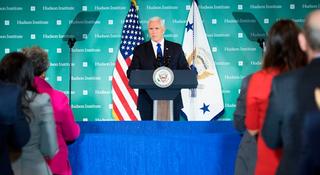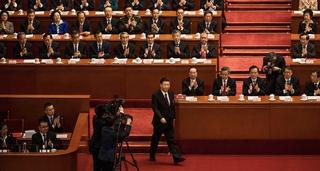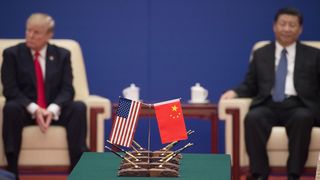Introduction
On 4 October 2018, US Vice President Mike Pence delivered a speech at the Hudson Institute think tank in Washington DC.1 In unusually pointed remarks, Pence laid out a comprehensive list of complaints about Chinese behaviour. According to the Vice President, ‘Beijing is employing a whole-of-government approach, using political, economic and military tools, as well as propaganda, to advance its influence’ at the expense of the US and international order.
The charge sheet was extensive. While previous administrations gave ‘Beijing open access to [the American] economy and brought China into the World Trade Organization’ (WTO) in the hope that political freedom and economic liberalisation would advance, that ‘hope has gone unfulfilled … and Deng Xiaoping’s famous policy [of reform and opening] now rings hollow.’
In addition to directly challenging America strategically and undermining the American role in upholding the international rules-based order that’s been cobbled together since the end of World War II, the Chinese Communist Party (CCP) ‘has also used an arsenal of policies inconsistent with free and fair trade … to build Beijing’s manufacturing base, at the expense of competitors—especially America.’ This includes tariffs, quotas, currency manipulation, forced technology transfer, intellectual property (IP) theft and industrial subsidies—the extent of which has been well documented—occurring at a scale unmatched by any postwar economy and constitutes a violation of WTO and other treaties.2 Such ‘wholesale theft of American technology’ is especially grievous, as it’s being used by Beijing, according to Pence, to turn ‘plowshares into swords on a massive scale’.
Moreover, China is misusing its economic size and weight in the form of ‘debt diplomacy’ to extend ill-gotten leverage over smaller countries and to ‘exert influence and interfere in the domestic policy and politics of [the United States]’. In a scathing assessment, Pence argued that ‘previous administrations all but ignored China’s actions—and in many cases, they abetted them.’ Then he offered the main point of the speech, which was to declare: ‘But those days are over.’
To be sure, the individual complaints made against China weren’t new. More broadly, the George W Bush administration initially characterised China as a rising challenger and ‘strategic competitor’ before taking the softer line of urging Beijing to become a ‘responsible stakeholder’ in the international system under American leadership.3 Barack Obama’s ‘pivot’ to Asia recognised China as a rival,4 and concerns about Chinese trade practices and IP theft preceded the Donald Trump administration.
Even so, no senior member of any administration has ever delivered such blunt remarks focused so exclusively on China’s wrongdoings and its unique and unprecedented challenge to America interests and international order. The speech went further than any other in naming China as a comprehensive competitor and rival prepared to integrate military, economic, technological and political weapons to undermine American strength, prosperity, resilience and capabilities. Nor were Pence’s remarks the isolated words of a Vice President letting off steam. The tone and content of Pence’s speech are consistent with the 2017 National Security Strategy5 and 2018 National Defense Strategy6 released by the administration. Those two documents represent the considered view of the agencies and departments responsible for American foreign, security and intelligence assessments and policy. In short, Pence’s speech was merely the sharpest arrow in the American quiver.

What’s changed?
For some in Australia and the region, the almost inevitability of deepening competition, and even rivalry, between the United States and China has been anticipated for some time.7 Concern with China’s behaviour isn’t just an American phenomenon. For example, the 2009 Defence White Paper concluded that ‘the pace, scope and structure of China’s military modernisation have the potential to give its neighbours cause for concern.’8 More recently, and in the implicit context of concern about China, the 2017 Foreign Policy White Paper commits Australia to work more closely with the region’s democracies to ‘support a balance in the Indo-Pacific favourable to our interests and promote an open, inclusive and rules-based region’.9
Most regional countries fear collateral damage from worsening US–China relations but remain focused on finding an acceptable balance in their relations with both great powers.
Australia’s perspective and positioning remain forward leaning compared to those of most other nations in the Indo-Pacific. Since Pence delivered his remarks at the Hudson Institute, the regional and global environment doesn’t appear to have significantly changed. Most regional countries fear collateral damage from worsening US–China relations but remain focused on finding an acceptable balance in their relations with both great powers. The EU recently declared China to be ‘an economic competitor in the pursuit of technological leadership, and a systematic rival promoting alternative forms of governance’, but has only committed to ensuring that ‘relations [with China] are set on a fair, balanced and mutually beneficial course.’10 As the conventional approach goes, the struggle between the United States and China is one between giants, and skilled statesmanship will avoid the worst of any fallout from that struggle.
It’s highly unlikely to be ‘business as usual’. There’s far more changing in what’s widely accepted as the most important bilateral relationship in the world than those advocating for a ‘small target’ or ‘hope, wait and see’ approach might appreciate. The trigger is primarily Chinese behaviour, but if Pence’s remarks represent the considered and consensus view of the current and future administrations—with support from the majority of the Washington policy establishment, corporate America and the American population (discussed below)—then other nations must more squarely confront the profound ramifications of both Chinese actions and American responses. Simply dismissing Pence’s remarks as undiplomatic bluster by an unconventional White House or else the impractical and inopportune declaration of a ‘new cold war’11 is analytically lazy and unhelpful for governments trying to better understand the changing dynamic.
The military implications of deepening strategic competition, if not outright rivalry, are obvious. There are several less obvious but possibly more profound and confronting implications. In giving appropriate weight to what Pence’s speech represents, this paper identifies three major shifts from what has been before—moving from the broadest to the more specific.
1. China can’t be shaped—but it should be countered
In early 2018, two former senior Obama administration officials penned an article in Foreign Affairs.12 They argued that America had demonstrated ‘an outsize sense of its ability to determine China’s course’. That sense was based on ‘the assumption that deepening commercial, diplomatic and culture ties would transform China’s internal development and external behaviour’. This had been Washington’s broad approach since the Richard Nixon era and has largely failed.
While previous administrations patiently put resources and attention in, hoping that China would pursue a more favourable trajectory, Pence is arguing that countering Chinese actions that detrimentally affect American power and interests ought to be the higher and immediate priority.
Pence’s speech is the first by a senior official to confirm a departure from the approach of the eight previous administrations dating back to 1969. The Trump administration isn’t necessarily deterministic in concluding that China’s internal and external behaviour can never be shaped or altered but is pointing to considerable evidence to make the case that China is moving in the opposite direction to political and economic liberalisation. China isn’t merely ‘free-riding’ and resisting becoming a ‘responsible stakeholder’ in the international system. Beijing is actively undermining the American-led international order that enabled China’s rise and actively undermining American leadership and capabilities and even interfering in US institutions.
Time and patience are no longer luxuries Washington can afford. While previous administrations patiently put resources and attention in, hoping that China would pursue a more favourable trajectory, Pence is arguing that countering Chinese actions that detrimentally affect American power and interests ought to be the higher and immediate priority.
From this change in the basic American policy mindset, several important developments flow.
2. Globalisation, interdependence and international economic institutions are worth supporting—but only if they produce ‘fair’ or at least neutral outcomes for America
There’s increased emphasis by the United States and countries such as Australia13 on the importance of preserving and advancing the international rules-based liberal order. The latter term refers broadly to a shared commitment by all countries to conduct their activities in accordance with agreed principles and processes that have evolved since the end of World War II. This includes international law and regimes such as the UN Security Council, regional security arrangements, treaties, trade agreements and diplomatic protocols. It also includes respect for ‘liberal’ values such as representative government and the importance of individual human rights.
In the era of uncontested US power, such as during the first decade and a half after the end of the Cold War, the rapid advance of globalisation and interdependence between nations was generally viewed in one of two main ways:
- The greater the participation by nations in the global system, and the more interdependent they became vis-à-vis the advanced liberal democratic nations, the more their values and interests would align with those of the United States; or
- Globalisation and interdependence were largely strategically indifferent and functional phenomena that facilitated international trade, the movement of people and capital, and other cross-border transactions.
With good reason, America is now challenging the validity of those two perspectives as they apply to Chinese participation in the global economy. This is most apparent in the frequent lamentations about Chinese economic and trade practices and frustrations about international institutions such as the WTO, which are designed to facilitate cross-border transactions.
In a lengthy report released by the Office of the US Trade Representative in March 201814 (updated in November 2018),15 the administration detailed an extensive list of complaints against Chinese trade and economic practices. China disputes the level of egregiousness of its practices, and other countries disagree on what the impacts of Chinese behaviour might be on their interests and the broader international economic system.
One should avoid inaccurate analogies. In deflecting from the reality of Chinese economic misbehaviour, some offer arguments that current events are simply a rerun of American concerns witnessed during a rising Japanese economy in the 1980s.16 This comparison is at best superficial. Japan was (and remains) an American ally and didn’t demonstrate any will or ability to challenge American strategic pre-eminence or the international order more broadly.
Moreover, the challenge posed by China is qualitatively different. For America, the scale of Chinese offences and their perceived impacts on the US economy make them too serious to ignore. In 2018, US–China trade was worth more than US$660 billion.17 From 1990 to 2017, Chinese foreign direct investment (FDI) into America was almost US$140 billion; American FDI into China in the same period was almost US$257 billion.18 China is the world’s largest manufacturing economy and the largest trading partner for over a hundred countries.
There’s another, more important, distinction between Japan in the 1980s and contemporary China. In addition to the greater size of China’s economic role and impact, there’s growing conviction that the problems are systemic and will worsen because they stem from the fundamental nature of China’s political economy. The existing liberal rules-based economic system is predicated on entities competing against each other through a commercially driven process. In that system, the role and capacity of governments (and political parties) to intervene in economic activity must be reduced and circumscribed. The liberal approach quarantines economic activity from political interference by governments to the extent possible and insists that the logic of commercial rather than political and strategic interests be allowed to follow its course.19
The more plausible and enduring complaint against China, which will outlast the Trump administration, is that Beijing participates in the global economy only to engineer a predetermined economic outcome that serves China’s economic and strategic interests and entrenches the ruling position of the CCP within China.
To be sure, Trump’s reasonable demand for ‘free and fair trade’ and ‘reciprocity’ is often undermined by the President’s personal focus on reducing the current account deficit with China (which is of lesser importance if not irrelevant to American power and influence). The more plausible and enduring complaint against China, which will outlast the Trump administration, is that Beijing participates in the global economy only to engineer a predetermined economic outcome that serves China’s economic and strategic interests and entrenches the ruling position of the CCP within China.
In this context, the US perspective is in good company. For example, the EU is increasingly accusing China of ‘failing to reciprocate market access and maintain a level playing field’. The EU has taken aim at ‘distortions in China’s economic system’, including Beijing’s state-driven policies such as ‘Made in China 2025’ and the preserving of domestic Chinese markets for ‘national champions’ and shielding those entities from legitimate competition. This is achieved:
through selective market opening; licensing and other investment restrictions; heavy subsidies to both state-owned and private sector companies; closure of its procurement market; localisation requirements, including for data; the favouring of domestic operators in the protection and enforcement of intellectual property rights and other domestic laws; and limiting access to government-funded programs for foreign companies.20
The EU also chides China for creating an unlevel playing field in common export markets by offering Chinese companies ‘access to state backed loans and export credits at preferential terms and applying different corporate and labour standards’. It calls out China for investments in many countries that:
frequently neglect socioeconomic and financial sustainability [and produce] high-level indebtedness and transfer of control over strategic assets and resources. This compromises efforts to promote good social and economic governance and, most fundamentally, the rule of law and human rights.21
In September 2018, trade ministers from the United States, the EU and Japan issued a joint statement criticising such practices.22 Indeed, global criticism and pushback against China’s Belt and Road Initiative is growing due to similar concerns.23
These issues go to the heart of China’s political economy and will remain unresolved by any US–China trade deal. Beijing won’t leave the commercial fate of its companies to the gods of competition, competence and chance. More than any other major economy, it’s prepared to use state power, laws, regulations, and resources to:
- ensure that state-owned enterprises and ‘national champions’ dominate in targeted sectors, domestically and internationally
- lock in guaranteed external markets for those entities, especially through its Belt and Road Initiative and the initiative’s Digital Silk Road arm
- support the use of forced or illegal IP transfers to allow state-owned enterprises and national champions to compete and eventually dominate
- rely on opaque and even corrupt political deals to create economic footholds for Chinese entities (such as occurred in Malaysia24 and the Maldives25).
These approaches inherently undermine what globalisation and interdependence are designed to facilitate and enhance: the maximisation of efficiency and creation of new opportunity for participants based on market forces. China’s approach in the global economy reflects its own political-economic set-up, which is designed to ensure that the CCP retains the levers of economic power and relevance. While all governments intervene in the domestic and global economy to some degree, the nature, scale and extent of intervention by the CCP and Chinese state mean that authoritarian China plays a vastly different game from other major economies in the global system. For example, a recent survey of the largest 98 companies in China revealed that less than one-quarter were privately owned.26 In all state-owned firms, the CCP has a significant if not decisive say in major corporate decisions and senior managerial appointments.27 Even when it comes to private firms, the Company Law of the People’s Republic of China stipulates the establishment of party committees in all commercial entities ‘to carry out the activities of the party in accordance with the charter of the Communist Party of China’.28 Similarly, the 2017 National Intelligence Law demands that ‘Any organization and citizen shall… support, provide assistance, and cooperate in national intelligence work, and guard the secrecy of any national intelligence work that they are aware of…’29 The poor separation of political and economic agencies allows the party-state to blatantly manipulate markets and distort competition to achieve the party’s goals.30

The US administration’s discontent with global economic institutions such as the WTO stems from this reality. Since 2009, of WTO cases involving the four largest economies—the United States, China, the EU and Japan—China has been involved in approximately 90 per cent of all cases brought against each other.31 Those advocating for a ‘WTO as usual’ approach to dispute resolution often point out that the United States has won the vast majority of cases it has brought to the WTO, and China has complied with an overwhelming proportion of decisions handed down.32
To be sure, the WTO is reasonably effective in adjudicating on cases where there are blatant and formal evidence of collusion between the state and Chinese enterprises, overt mandatory obligations placed on foreign firms to purchase inputs from local firms, or the flagrant granting of exclusive rights to arbitrarily chosen firms to distribute or sell in the domestic market.
The problem is that WTO rules weren’t designed to deal with a Chinese political economy that’s neither a ‘command economy’ nor a ‘market economy’ as established under existing trade rules. In particular, the complex and opaque networks of relationships and connections between the CCP, the state, regulatory entities, administrative entities, businesses and individuals are unique to China and unprecedented in scale and density among nations.
The WTO rules were simply not designed to cope with the deep and opaque connections between the authoritarian regime of Xi’s CCP and all economic actors within China, whether state-owned or ‘private’.
How do we legally determine whether an entity is associated with the CCP or the Chinese state? All major Chinese firms must establish an internal party committee. Even so, existing rules can’t decide whether that entity qualifies as an ‘extension of the state’. The WTO prohibits certain subsidies provided by governments and their associated entities but can’t formally rule whether Chinese firms (which have close connections with the CCP) ought to be considered ‘associate’ entities.33 This means there can be no adjudication on the massive cross-subsidisation between Chinese firms, which continues unabated. The WTO rules were simply not designed to cope with the deep and opaque connections between the authoritarian regime of Xi’s CCP and all economic actors within China, whether state-owned or ‘private’.
Many more potential cases will never be brought before the WTO because it doesn’t have either the jurisdiction or the existing body of case law to resolve these basic questions. The opacity of the Chinese political economy also makes the gathering of evidence required for a formal case distinctively difficult. It is also highly unlikely that China would agree to reform or renegotiate the text of the Marrakesh Agreement, which established the WTO, in a manner that would significantly address these issues. Indeed, the failure of APEC leaders to agree on a written declaration for the first time at the conclusion of APEC’s November 2018 meeting in Papua New Guinea was largely due to China refusing to accept the need for WTO reform to address ‘unfair trade practices’ in the document.34 One must remember that Beijing’s higher priority is to achieve the economic and strategic objectives laid out in policies such as the Belt and Road Initiative and Made in China 2025, rather than to address WTO weaknesses that currently offer its political economy unique advantages and cover.
Additionally, the WTO is primarily designed to deal with trade-related issues rather than issues involving the forced transfer or theft or IP. Meanwhile, estimates of the cost to the US economy of Chinese IP theft range in the hundreds of billions of dollars.35 At least one in five members of the American Chamber of Commerce in China have revealed that they’re pressured to transfer technology to Chinese firms in order to continue their operations in the Chinese market.36 This must be understood in the context of current Chinese industrial policies that call for the ‘absorption, digestion, and re-innovation of foreign intellectual property’37 to meet the Made in China 2025 goal of 40 per cent self-sufficiency by 2020 and 70 per cent by 2025 (which arguably violates existing WTO ‘local content’ rules).
The general point is that, according to the theory and practice of economic globalisation, the growing interdependence between economies needs to be mutually beneficial to be sustainable. Benign outcomes are most likely when participants have similar commitments to economic liberalisation, significant separation between state and economic actors, and transparency in the way commercial transactions are designed and executed.
It’s clear that the United States is increasingly unwilling to passively accept the economic outcomes (and strategic corollaries) of a system when its major strategic rival is competing according to a different set of rules in order to rig the results and game the system.
In liberal economies, there are limits and restrictions on the extent to which governments can force firms to do their bidding and the extent to which firms make suboptimal commercial decisions in order to fulfil national objectives set by a political party or a state. Indeed, the WTO works best when these conditions are prevalent.
China has moved in the opposite direction on all these indicators, notably since President Xi took power. The Trump administration might well be taking a somewhat confusing approach when it comes to economic relations with China and other countries in occasionally emphasising the elimination of current account deficits over other more important issues. Nevertheless, it’s clear that the United States is increasingly unwilling to passively accept the economic outcomes (and strategic corollaries) of a system when its major strategic rival is competing according to a different set of rules in order to rig the results and game the system.
3. Civilian technologies, value creation and supply chains will be weaponised and guarded
The general trend over the past few decades has been the lowering of tariffs and other behind-the-border barriers between all major trading economies. This has occurred alongside the rapid globalisation of supply chains involved in the production of goods and services, which has created significant benefits for all participants: the prices of consumer goods and services are lower than they otherwise might be, inflation is suppressed, cross-border innovation is expedited, and there’s greater purchasing power for consumers and firms. In a more benign environment, little thought was given to the longer term economic or strategic ramifications.
Deepening strategic competition between the United States and China means a different perspective is taking hold. In 2009, two academics from Harvard Business School published an article lamenting the ‘hollowing out’ of the American industrial base and the dangers of US firms outsourcing production and cutting domestic investment in R&D.38 They produced figures to show that America had experienced a trade deficit in high-tech products since 2001 (and continues to do so to this day.) The part of the paper that most caught the public’s attention was the revelation that ‘America can’t make a Kindle.’ When the authors took apart an Amazon Kindle, they found that there was nothing in it manufactured in America.
Pence alleges China has for too long used the illegitimate methods discussed above to build its ‘manufacturing base at the expense of competitors—especially America’. The focus on preventing the alleged ‘hollowing out’ of the American industrial and manufacturing base offers only a small hint of what the developing US response might look like. Paying attention only to how many parts of a finished product is ‘made in America’ is somewhat of a red herring. More important when it comes to understanding how economic competition between the United States and China might play out is to identify trends in how economic value will be created into the future.
More important when it comes to understanding how economic competition between the United States and China might play out is to identify trends in how economic value will be created into the future.
Value chains are evolving and changing rapidly. The creation of economic value is becoming more knowledge-intensive and reliant on high-skilled labour and less dependent on inputs from low-skilled labour. This makes sense, given the advances in technologies that replace low-skilled labour, such as automation. This trend is reaffirmed by one calculation that investment in intangible assets (such as R&D, brands and IP) as a share of revenue has increased by almost 250 per cent, from 5.5 to 13.1 per cent, since 2000.39
While the trade in lower-value-creating manufactured goods is actually becoming more regional rather than global (as companies are producing more of those goods in closer proximity to the final consumers), trade in higher-value-creating goods and services (such as software and digital platforms; internet and communication technologies; robotics and automation technologies; aerospace technologies; new and advanced materials; biotechnology and higher skilled services) is becoming more global. As it turns out, those are precisely the sectors and technologies that have been identified as priorities in the Made in China 2025 blueprint.
In the strategic rivalry, the meaningful battleground isn’t the size of the US current account deficit with China. China could easily reduce the trade deficit for the United States by mandating a temporary increase in the purchase of products from America. That would immediately offer Washington a better set of current account numbers without meaningful advantage or gain. The concerns that Pence raised in his speech would barely be addressed.
The more meaningful and serious contest will become apparent (or is already) in the following ways.
First, there will be more US attempts to capture a greater share of the value chain across a growing number of sectors and deny it to China. An analysis of tariffs levied under section 301 of the Trade Act of 1974 against Chinese goods by the White House revealed that 80 per cent (by value) of the targeted trade with China was in industries identified as ‘patent-intensive’ by the Department of Commerce.40 They include computer/electronic products and machinery/equipment. Those sectors constitute about 30 and 22 per cent, respectively, of Chinese exports to the United States.41
One of the justifications offered by the United States is that these are the industries heavily targeted by China when it comes to forced transfers and thefts of IP. In addition to ‘targeting’ Chinese-based firms in these high-value-creating and patent-intensive industries, the tariffs seem designed to make it less commercially attractive for foreign firms to invest in or engage in joint or cooperative ventures with local firms to produce high-value-creating intermediate parts in China. These two broad sectors (computer/electronic products and machinery/equipment) are prominent in integrated regional and global supply chains. Moreover, approximately one-third of all Chinese exports of these products into the United States is directly related to the business operations of American-based firms.42 In other words, around one-third of these Chinese products imported into the United States forms part of the supply chain for American-based firms.

Further analysis reveals that around two-thirds of these industries’ products imported from China to the United States are produced by foreign-invested firms based in China. This is significant because, in theory, those firms don’t have to base operations in China. In addition to concerns about IP transfers and theft, tariffs levied on those China-based firms make it commercially less attractive for foreign-invested firms to base operations in China when the next or end destination for that product is the United States.
Indeed, senior figures within the administration such as Peter Navarro, Director of the White House National Trade Council, have spoken openly and frequently about ‘repatriating’ supply chains away from China.43 Presumably, repatriating the high-value parts of the supply chain back to America is the higher priority.
As it turns out, the combination of tariffs and ongoing economic tension and uncertainty is causing many multinational firms to explore supply-chain options outside China.44 That trend was already occurring due to normal economic considerations, such as rapid increases in average manufacturing wages in China, which are predicted to be double in 2025 what they were in 2015.45 Higher costs, logistical impracticality and other factors will prevent many of those firms transplanting operations into America, and the reality of regionalised supply-chain infrastructure already in place means that Southeast Asian countries such as Vietnam and the Philippines are likely to be the major beneficiaries. Even so, that would advance the strategic objective of moving high-value-creating production away from China, lessening American supply-chain reliance on a strategic rival and making it more difficult for China to develop its own advanced industrial base.
It’s highly significant that the revamped US–Mexico–Canada trade agreement includes a provision that requires members to give notification of any trade negotiation with a ‘non-market’ economy (read ‘China’). If one of the parties subsequently enters into an agreement with a non-market country, the others can exit the three-way agreement and form their own bilateral pact. This effectively makes it difficult for Canada or Mexico to conclude any meaningful bilateral agreement with China, as the threat of the United States withdrawing is a considerable one.
The second sign of a more serious contest is that we’re increasingly entering a bifurcated world when it comes to ‘critical technology’, and the definition of that term will only widen and expand over time. This is a deeper kind of economic decoupling than the supply-chain shifts in manufacturing outlined above. It will occur in the high-technology economy.
In August 2018, the Foreign Investment Risk Review Modernization Act46 was passed with strong bipartisan support. Previously, the US Committee on Foreign Investment was only entitled to examine transactions by foreign entities aimed at taking over or gaining a controlling stake in American companies. Under the newer legislation, the committee will be able to review a greatly expanded array of proposed deals, including joint ventures and smaller investments by foreign entities in businesses that produce technology deemed to be of critical importance.
Increased pressure will be exerted by the United States and China on other countries to adopt their preferred infrastructure, platform, software, supply chain and so on, even if the economic costs, transactional costs, or both, to do so are higher.
Prominent businesspeople, such as Google’s Eric Schmidt, have already predicted that there’ll be ‘two internets’, led by the United States and China.47 The exclusion of Huawei from the 5G networks of the United States, Australia and New Zealand is further evidence of bifurcation.
It’s important to note that technological bifurcation is both a driver and a consequence of the supply-chain and value-chain competition discussed above. Increased pressure will be exerted by the United States and China on other countries to adopt their preferred infrastructure, platform, software, supply chain and so on, even if the economic costs, transactional costs, or both, to do so are higher. The purpose is to ‘lock in’ other countries to their preferred technological ecosystem or operating system and prevent the rival from doing the same to other countries. Of course, this isn’t a ‘like for like’ choice. The consequences of buying into the technological ecosystem of an authoritarian state such as Xi’s China are very different from those that flow from participating in an ecosystem with US and other partners’ technologies at the core of a nation’s digital infrastructure. This is already playing out in the competition to present smaller countries with alternatives to reliance on Chinese-funded and Chinese-designed technology and infrastructure.
There’s no ‘waiting this out’ for Australia
The deepening tension isn’t a transient phase in US–China relations. China has long treated America as a comprehensive rival.48 The United States has finally accepted that reality, and that pessimistic conversion is deep and enduring. The administration’s turn against China is perhaps the only policy of Trump’s that the Democrats overwhelmingly support.49 Senate minority leader Charles Schumer praised Trump’s decision to place tariffs on China50 and joined with other Democrat Senators to urge the President to ‘stand firm against China if meaningful concessions [were] not made’ prior to the Trump–Xi meeting in November 2018.51 Elizabeth Warren and Bernie Sanders, who will contest for the Democratic nomination and hail from the left of the party, agree. The former believes that China has ‘weaponized its economy’ and is ‘using its economic might to bludgeon its way onto the world stage’,52 while the latter supports the effort to ‘combat forces of global oligarchy and authoritarianism’.53 Any time spent in the think tanks of Washington DC will reveal a darkened mood about China. As one Trump administration source put it, the hardening stance against China ‘should not be painted as mere America First-ism … This is an overdue response that’s basically a consensus view of security people in Washington on both sides.’54
Much of the American business community has shifted remarkably from positive to negative views of China.55 According to its 2017 annual survey, more than four-fifths of the members of the American Chamber of Commerce in China believe that foreign firms are less welcome than they were in the past, and most are sceptical that China will genuinely open its markets further to outside competition.56 In the corresponding 2019 survey, almost three-quarters of respondents in the technology and other R&D-intensive sectors cited market restrictions and other Chinese Government practices (such as the opaque implementation of laws and regulations) as their top concern.57 While many admitted the tariff war was causing them economic pain, more than half wanted the tariffs to remain in place until meaningful reforms and concessions are made by Beijing. As AmCham China Chairman Tim Stratford noted, Chinese reforms tend to take place only after domestic firms establish dominance over foreign rivals.58
The future may be better or worse depending on whether the Chinese Communist Party and Chinese state under President XI can be convinced or compelled to change some of their practices.
Finally, the American public is increasingly in agreement. According to a June 2018 Gallup Poll, 62 per cent of Americans believed China pursued an ‘unfair’ trade policy towards the United States, even as their views of the trade policies of the EU and Canada (two other economic entities that have been criticised by Trump) remained positive.59
In this age of strategic hypercompetition, as presaged by Pence’s speech, the United States will become more tolerant of economic and transactional costs associated with competing against a strategic and economic rival—and will expect allies and friends to think similarly.
When it comes to security policy, military posture and countering aspects of China’s economic policies in Southeast Asia and the Pacific that have strategic implications negatively affecting Australian interests, Canberra is largely on board.60 Similarly, Australia is robustly pursuing its own interests in protecting its critical infrastructure and repelling dangerous trends in foreign interference and covert influence in our institutions and decision-making.
However, Australia has barely begun to think through the implications of the transformational shifts suggested in this paper. The ‘holding position’ of pleading for all countries to reject ‘protectionism’ and resort to WTO and existing protocols to resolve outstanding grievances deeply underappreciates the extent to which China is undermining the international economic system, the continued impotence of the WTO in resolving important matters, and why the United States is changing its previous tolerant mindset and responding as it is. Other major liberal democracies entities, such as the EU and Japan, might not be as forward leaning as the United States, but neither are they standing still.
The future may be better or worse depending on whether the CCP and Chinese state under President XI can be convinced or compelled to change some of their practices. In addition to the issues raised in this paper, other illegitimate practices include Beijing resorting to economic coercion and punishments to illegitimately force smaller states to change strategic or political decisions.61 Much will also depend on whether the United States can be persuaded to follow wise direction. This must include revisiting its decision to leave the Trans-Pacific Partnership, which addresses many of the issues unattended to by the WTO and might have been used to exert pressure on China to change its practices or suffer perpetual exclusion.
Whatever is unfolding, it will be vastly different from what came before.
This report was produced in partnership with the Australian Strategic Policy Institute.




.jpg?rect=0,80,3000,1989&fp-x=0.5&fp-y=0.44772296905517583&w=320&h=212&fit=crop&crop=focalpoint&auto=format)

